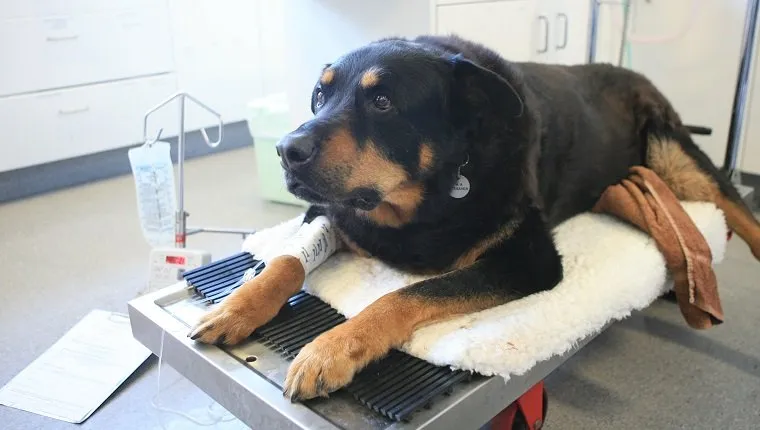Anemia in dogs is a condition that results in a reduced count of red blood cells, hemoglobin, or both in the blood stream. The function of red blood cells and hemoglobin is to bring oxygen from the lungs to other parts of the body.
There are several types of canine anemia with various symptoms that can affect dogs, and they often have different causes and treatments. While some severe forms of the disease can present life-threatening symptoms to anemic dogs, many mild cases can be managed or reversed with proper veterinary care.
If you see signs of the condition in your dog, then you must get to your veterinarian for a proper diagnosis and treatment. Here’s what you should know about the types, causes, symptoms, and treatments for anemia in dogs.
Types & Causes Of Anemia In Dogs

There are several types of anemia in dogs.
In healthy dogs, red blood cells — also known as erythrocytes — carry protein molecules called hemoglobin that bring oxygen from the lungs to all body tissue. Red blood cells have a lifespan of about two months before the spleen removes them from circulation.
Bone marrow recycles some parts of hemoglobin molecules to create new blood cells, while the liver filters the rest. The process then repeats. Different forms of anemia create irregularities in this process.
Here are a few types of canine anemia and their causes:
- Blood loss anemia happens following a severe loss of blood, typically due to injury, surgery, or a bleeding disorder. It can also be caused by internal bleeding due to ulcers, parasites, cancer, or other conditions.
- Hemolytic anemia is caused by destruction or shortened lifespan of red blood cells. This can be immune-mediated hemolytic anemia (IMHA) or autoimmune hemolytic anemia (AIHA), conditions where white blood cells attack the body’s own cells, and antibodies destroy the red blood cells. It can also be non-immune mediated, which is caused by parasites, hereditary disease, toxins, or low phosphorous levels.
- Aplastic or non-regenerative anemia means there’s insufficient production of red blood cells. Several factors can cause this, including bone marrow disease and tumors, kidney disease, parvovirus, chemotherapy drugs, certain medications, or sometimes radiation or toxin exposure.
- Methemoglobinemia happens when there’s too much methemoglobin in the blood. Hemoglobin carries oxygen, but methemoglobin doesn’t. It’s the result of iron oxygenation and is normally converted back into hemoglobin. When that process is disrupted, the methemoglobin levels get too high, and blood may appear brownish in color as it loses oxygenation. This type of anemia is caused by genetic disorder or exposure to chemicals including some medication like ibuprofen, acetaminophen, and benzocaine.
Symptoms Of Anemia In Dogs

Symptoms that appear in anemic dogs can range from mild to severe and may also vary depending on the type of anemia that a dog suffers from. In some cases dogs may present no signs, so it’s important to keep up with regular veterinary exams.
Here are some signs to watch for and seek veterinary attention if you spot them:
- Pale gums
- Paleness in the eyes or ears
- Discoloration of the skin or mucous membranes
- Weakness, tiredness, or depression
- Lack of appetite or weight loss
- Black stools
- Ingesting dirt
- Vomiting
- Swelling in the face or jaw
- Fast pulse
- Rapid breathing
- Hypothermia
Treatment & Prevention Of Anemia In Dogs

Treatment for anemia depends on the type and cause of the condition. Your veterinarian will run tests and, after that, form a diagnosis.
These tests will likely include a red blood cell count, tests for parasites, evaluations of liver, kidney, and pancreatic functions, electrolyte tests to check for dehydration, a urinalysis to check for urinary tract infections, and further tests to rule out certain causes.
Depending on the type of anemia your dog suffers from, your vet may consider the following treatment options:
- Intravenous fluids
- Blood transfusion, especially in life-threatening cases
- Bone marrow transfusion
- Antibiotics if the cause is bacterial infection
- Changing medications that may cause anemia
- Immunusuppressive drugs in the case of IMHA or AIHA
- Gastrointestinal medication
- Parasite or de-worming medications
- Potassium phosphate supplements
Your vet may also consider other options. It’s also important to follow methods of preventative care.
Prevention of anemia in dogs should include the following:
- Flea and tick medication to prevent illnesses that they carry, which cause anemia
- Avoid exposure to toxic substances like lead
- Avoid ingestion of human medications, including ibuprofen and acetaminophen
- Keep up with parasite prevention medication
- Avoid exposure to human foods that are toxic to dogs like onions
- Avoid major injury by supervising your dog while outdoors and do not allow them to roam into streets
Has your dog ever suffered from anemia? How did you treat it? Let us know in the comments below!









